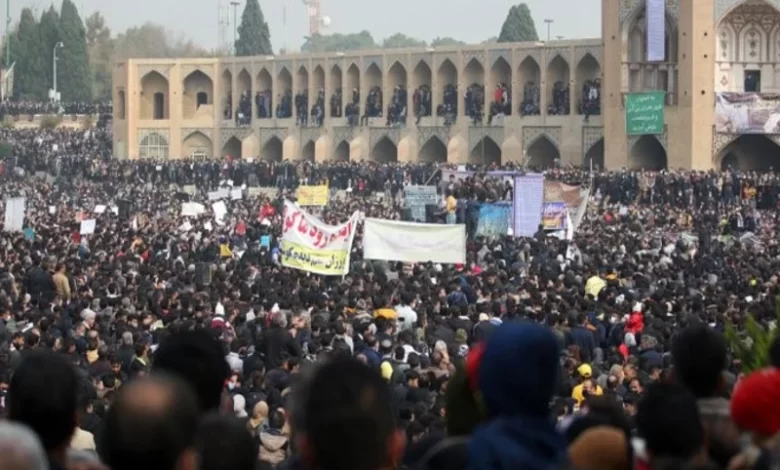Ongoing Protests in Iran: Is the Country on the Verge of a Revolution?

Written by
Mahmoud Hakamian
Every day, news of protests expanding across Iran is wired. Iranians from all walks of life have been taking to the streets and demanding their rights on a daily basis. Protests in Iran had increased since June 2021, when the regime selected Ebrahim Raisi as its next president.
The Iranian opposition president, Mrs. Maryam Rajavi, underlined there will be a “new era” following Raisi’s inauguration, where “hostility and enmity between the Iranian regime and society will intensify more than ever before.” That inauguration took place in August, and protests erupted almost immediately in various regions of Iran.
A new era will dawn in Iran, a society based on democracy/separation of religion & state, &gender equality #FreeIran pic.twitter.com/Pkw89owIVj
— Maryam Rajavi (@Maryam_Rajavi) July 9, 2016
Since then, unrest among the Iranian people has followed a general upward trend, with November yielding an especially high number of reports about large-scale protests over various issues, in numerous cities and towns involving a range of demographics.
In the last two weeks of that month, workers from various industries held demonstrations to protest layoffs, unpaid wages, and a lack of government support, while retirees protested the greater economic hardships brought on by the shrinking values of their pensions. During the same period, large-scale gatherings took place among victims of cryptocurrency scams and embezzlement schemes, the families of victims of the January 2020 missile strike that brought down a commercial airliner near Tehran, and persons affected by water shortages in several regions.
In each case, protesters held regime authorities responsible for the issues at hand. One protest over financial matters focused on the theft of customers’ money by the Caspian Credit Union, an institution closely linked to the Islamic Revolutionary Guard Corps. The IRGC was directly responsible for the Flight 752 disaster, while its front companies are the key beneficiaries of an explosion of dam construction projects over the past three decades, contributing to ecological degradation, including the drying of waterways.
One such waterway, Zayandeh Rud, was the focus of especially large-scale and restive protests in Isfahan Province in recent days. On Thursday, farmers from that province gathered in the river’s dry basin to condemn the Iranian regime’s policies and demand the opening of a dam that retains water necessary for their livelihoods. Soon after that, security forces and the IRGC attacked the demonstration and dispersed its participants, but many more returned the following day to continue the protest despite persistent threats of violent repression.
Hundreds injured, arrested in Isfahan protests—Iran news
Far from effectively suppressing the demonstration, those threats have actually sparked more support for the farmers among other walks of life in Isfahan. According to the People’s Mojahedin Organization of Iran, which maintains an extensive intelligence network inside Iran, some activists banded together to obstruct a motorcade that was bringing riot police to the site of the demonstrations on Friday. The PMOI also reported that slogans began to evoke a broader political message as the unrest grew throughout that day, including outright demands for regime change.
In this way, recent demonstrations in Isfahan and elsewhere follow the same pattern as the nationwide uprisings that challenged the mullahs’ hold on power in 2018 and 2019. The first of these began with a protest in Iran’s second city of Mashhad, which was focused on worsening economic conditions, but soon spread to well over 100 cities and towns. At the height of that uprising in January 2018, Supreme Leader Ali Khamenei contradicted years of government propaganda by acknowledging the PMOI’s role in popularizing slogans like “death to the dictator.”
The second uprising, in November 2019, was initially sparked by the government’s announcement of a sharp increase in gasoline prices. But the same slogans immediately came to define the resulting simultaneous demonstrations in nearly 200 localities. In response, regime authorities cracked down much harder on the second uprising, killing over 1,500 participants in mass shooting incidents over only several days, then initiating a campaign of systematic torture against many of those arrested in connection with the unrest.
Iran Protests: Nationwide Uprising in Iran- November 2019
The second anniversary of that uprising and crackdown seems to have contributed to the surge of widespread unrest in November. Indeed, the MEK’s “Resistance Units” marked that anniversary by posting images of some of the victims in public spaces. These were generally accompanied by appeals for the Iranian people to hold new demonstrations in honor of the victims and the cause for which they died.
“The blood of 1500 martyrs of the Nov. 2019 uprising has intensified the will for more uprisings and rebellion,” read one poster in the city of Ramsar. Such statements are distinctly reminiscent of Mrs. Rajavi’s prediction for an unprecedented increase in popular unrest at a time when the Raisi administration is expected to amplify a trend of repression. Meanwhile, the regime’s oppression becomes more ineffective daily.
“Every day, teachers, workers, civil servants, retired government employees, creditors, and people of all walks of life are gathering in different parts of Iran to protest unemployment, poverty, inflation, rising prices, and government corruption,” said one editorial on the PMOI’s website, adding that the large-scale unrest in Isfahan “is only a prelude to what is awaiting the regime down the road.”
The regime authorities have no pathway out of the crisis that all this recent unrest represents for them. Further crackdowns, according to MEK, “will only infuriate a people who no longer fears its apparatus of repression,” while a hands-off approach to the situation will only prompt current trends of unrest to “continue to grow, join and become bigger movements that evolve from [expressions of] economic grievances to demands for regime change.”

